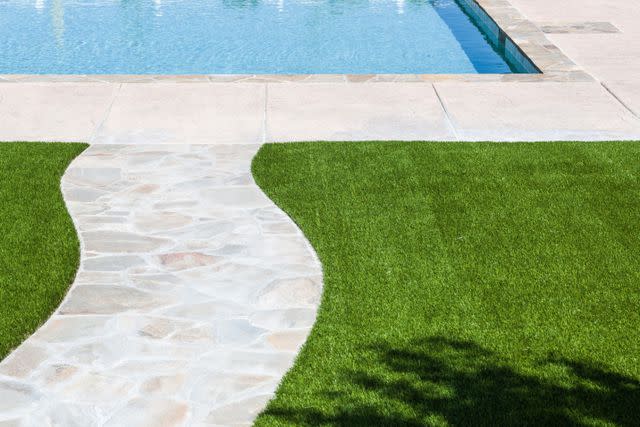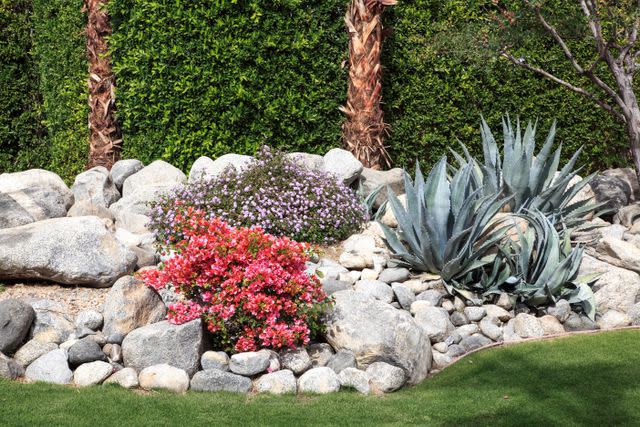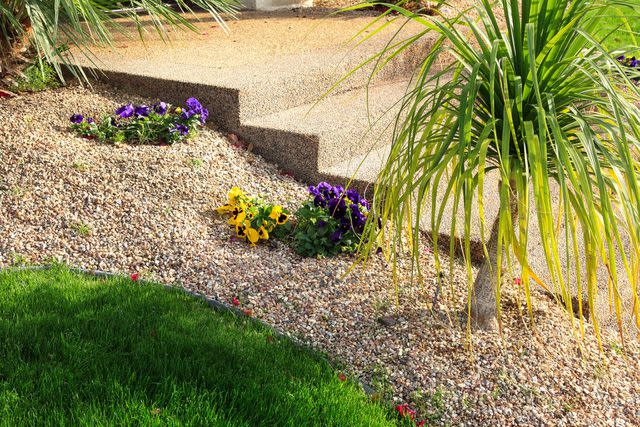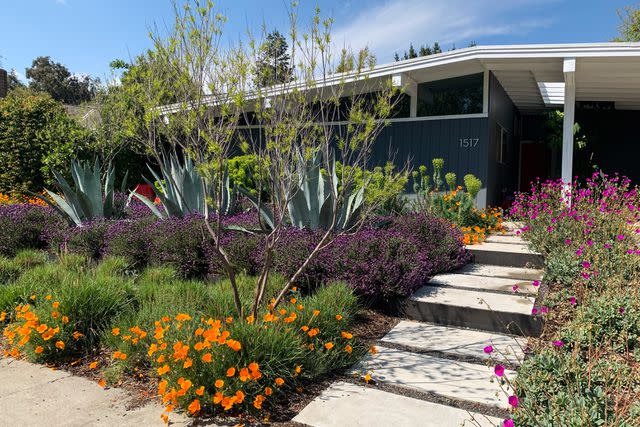Are Picture-Perfect Grass Lawns on Their Way Out? Why Natural Is the New Beautiful
The American lawn has deep roots in our nation's founding story, but environmental concerns have sparked interest in native plants and a wildlife-friendly landscape.
:max_bytes(150000):strip_icc():format(jpeg)/blue-house-beautiful-lawn-garden-getty-0423-daf348a98db140b3b6adaa86402754fd.jpg)
Getty Images
Poking through her garden in California's Central Valley, Haven Kiers spotted tiny eggs clustered throughout the lupine. Kiers, a landscape architect with the University of California, had planted the native from seed, envisioning an ocean of lavender spires that would thrive through the region's hot, dry summers.
Now, she had an ocean of eggs.
Were they friends or enemies? She hurried to her laptop to search "oval yellow eggs"—and broke into a smile when the culprit popped up: ladybugs.
"Where there's lupine, there will be aphids," she says, describing the latter as plant-munching pests. "The ladybugs know that lupine is a good spot to lay their eggs, because when the larvae hatch, they will have food at the ready. They are our heroes who swoop in and eat the aphids."
It's just one of the natural alliances homeowners are learning to love as they transform lawns into landscapes brimming with native plants. And while the switch requires some effort and green up front, its rewards add up quickly. In dry regions, native plantings stand tough through drought; in rainy ones, their deep roots slow runoff and erosion. An earth-friendly lawn also keeps on plugging without chemicals and gas-powered equipment that pollute streams, lakes, and air.
How We Got Here

Feverpitched / GETTY IMAGES
The Western lawn's love story probably began in France when Louis the XIV transformed the meadows and marshes surrounding the Palace of Versailles. Dotted with fountains and sculptures, his manicured property inspired noble lawns and parks throughout 1600s Europe, creating an aesthetic that crossed the Atlantic with America's founders. You can still see it in Thomas Jefferson's Monticello, George Washington's Mount Vernon, and the U.S. Capitol grounds in Washington, DC.
"A tidy lawn signaled mastery over nature, financial success, and a shared American value." — Steward T. A. Pickett, urban ecologist with the Cary Institute of Ecosystem Studies
After World War II, middle-class homeowners embraced turfgrass as part of the American dream. Entrepreneurs put wartime chemicals to new use as weed killers and fertilizers, and residential lawnmowers upped everyone's expectations.
A tidy lawn signaled mastery over nature, financial success, and a shared American value, says urban ecologist Steward T. A. Pickett with the Cary Institute of Ecosystem Studies in New York's Hudson Valley. "And none of those things have much to do with biodiversity, enhancing food webs that can live around our houses, or supporting the various sorts of local species that we can enjoy," he says.
A New Approach Takes Root

Solidago / GETTY IMAGES
Landscape designer Owen Wormser grew up away from all that in Maine's North Woods. Inspired by the 1970s back-to-the-land movement, his parents had built their lives off the grid, where Wormser entertained himself by tracking wildlife through native trout lilies.
Hoping to share the well-being he had found in nature, he studied landscape architecture at the University of Massachusetts Amherst. But for the first two decades of his career, homeowners seemed unable to imagine replacing turfgrass with native plants. That started to change about 10 years ago, but really gained momentum in 2020 as concerns about the environment climate change went mainstream, he says.
In his book Lawns Into Meadows, Wormser describes some of those concerns, including the risks lawn chemicals pose to humans and animals. Sometimes, the consequences are as subtle as an empty birdhouse. Other times, they're as jarring as a lake blooming with toxic blue-green algae.
It's easy to blame farmers. But American home and property owners use an estimated 100 million tons of synthetic fertilizer to green up their lawns every year—up to 10 times more chemicals per acre than farmers use to grow food.
Nurturing a Better Future

Solidago / GETTY IMAGES
Dorothy Whitmer didn't realize she was part of the problem until she took an online quiz developed by a Michigan watershed protection group. "I flunked," says Whitmer, who lives with her husband on Gull Lake in Central Minnesota. "And I freaked. I spent three years trying to figure out how I and so many others have been so far off."
Whitmer contacted nonprofit Minnesota Lakes and Rivers Advocates (MLR) to pitch a lake health program. She developed a quiz, yard signs, and a website page to teach property owners to create buffer zones—unmowed strips of trees and native plants that absorb lawn chemicals before they reach the water. Minnesota now has 35 Lake Steward programs.
Jeff Forester, MLR's executive director, says the yard signs have been instrumental in shifting people's shoreline aesthetic and concept of beauty from manicured to natural. "At first, the neighbors with the lawn right down to the water are like, 'Gosh, those guys—their yard is such a mess,'" he says. "Well, once we give them an award and put a sign on it, it's like, no, it's not a mess. It's a lake steward, and it's protecting the lake."
In Western states, the push has come from legislators contending with a historic drought and a dwindling Colorado River that threatens water and power supplies. California now offers tax breaks to homeowners who replace their lawns with drought-tolerant landscaping, and Nevada laws prohibit the installation of irrigated grass in new residential and commercial developments.
Kiers worries that legislation can generate negativity: "Then it becomes all about, 'How do I meet the very bare minimum because I'm being forced to do this?'" And besides, there are so many reasons to love native plants, she says.
"Traditional lawns are huge water hogs, and they require fertilizers and a lot of ongoing care. By removing your lawn, you are actually essentially removing maintenance." — Cate Singleton, landscape architect
Cate Singleton, a landscape architect with Tilly Design, sees hesitance, too. The leader of a team that develops Certified Wildlife Habitats, she's increasingly hearing from homeowners concerned about pollinators—still, "trying to tell people to remove their lawn is tough," she says. "But starting with the small things can give you a sense of accomplishment. You know, 'This is my little wildlife habitat. I'm moving this toward a more sustainable landscape.'"
Ultimately, native plants ask a lot less of homeowners. "Traditional lawns are huge water hogs, and they require fertilizers and a lot of ongoing care. By removing your lawn, you are actually essentially removing maintenance," says Singleton.
Related:Rebranding the Great American Lawn for the 21st Century
Natural Is the New Beautiful

Haven Kiers
The movement is still young, but it's gaining ground as TikTokers ("sustainable lawn" videos have over 4 billion views on the platform) and groups like Homegrown National Park demonstrate how an eco-conscious lawn can look curated. With a boxwood hedge, steel edging, or a neatly mowed lawn border, a section of native plants and grasses appears purposeful and tells a story of hope, Kiers says. "Suddenly, it brings in this narrative that people like and aspire to," she says. "And then when you start talking to your neighbors about it, you can talk about bringing in butterflies and songbirds and pollinators, which are starting to be more hip words."
Those conversations build buy-in. "Before I would put a shovel in the ground, I might say, 'Hey, did you notice the cardinals have come back? Here are the kinds of plants that help them,'" Pickett says.
Landscape designers and plant companies will play an important role in facilitating change, Pickett adds. But Kiers envisions a homegrown shift, with people creating Pinterest pages for their favorite native plants and talking over the back fence.
Within 10 years, she and others believe many homeowners will have replaced at least some turfgrass with locally adaptive plants and started to enjoy discovering new native favorites, like nectar-rich purple coneflower in the Midwest, beautiful bee balm in New England, and sun-loving phlox across the South.
In 20 years, we'll be expanding our native gardens. And while we will always want some backyard turfgrass, yards from region to region will look less generic. "I think we'll get to those place-identifying plants that really create a local identity," Kiers says.
In 50 years, eco-savvy homeowners will likely have larger swaths of pollinator-friendly natives. Neighbors might even collaborate to create garden "highways" that bees and butterflies can follow from one place to the next, ensuring a mix of plants that bloom from spring through fall.
That's the future Forester already glimpsed at the South Minneapolis house where he and his wife raised their two daughters. Flanked by apartment buildings, their property is lush with clover, violets, and milkweed.
"One day when my girls were little, like three and five, we were hanging out on the front porch," Forester recalls. "All of a sudden there was a hatch of these little blue butterflies." Eyes wide, the girls crept into the yard and reached up, allowing the gentle creatures to land on their fingertips. "It was so beautiful, it almost made me weep."
His daughters are grown now, but they still talk about that day. "So that's the aesthetic that I see," he says. "Life is my aesthetic."
Frequently Asked Questions
I want to convert to a sustainable lawn, but I'm overwhelmed! How do I begin?
I am an advocate of taking it small, getting the wins, gaining the confidence, and then continuing to build on that. Start by carving out a little piece of your lawn for a few native shrubs and some perennials that you love. I also like using native annual wildflower seeds to fill in spaces and keep down the weeds. —Haven Kiers
Where will my kids and dog play if I take out my lawn?
Even ground covers that can take some foot traffic are going to get beat up with kicking balls and a lot of activity. I think in this situation, you look at reducing your lawn rather than eliminating it. —Cate Singleton
My state prohibits irrigated grass. Should I consider artificial turf or gravel?
A little bit of gravel works as a pathway, but I don't recommend gravel or plastic as a lawn. Both are going to absorb and reflect heat, so the temperature rise is going to be significant around your property. And if you've got trees, it's going to heat up their roots. Also, the only way to cool down or clean plastic grass and gravel is by spraying it with water. If you use pathways and native plants, you shouldn't have to water at all. —Haven Kiers

